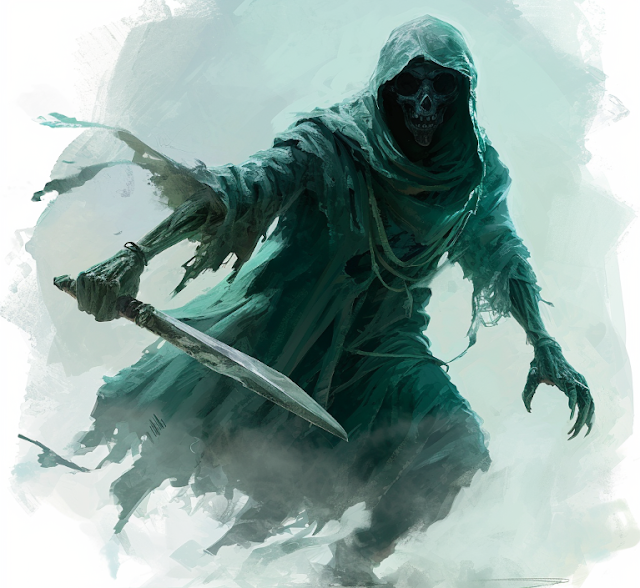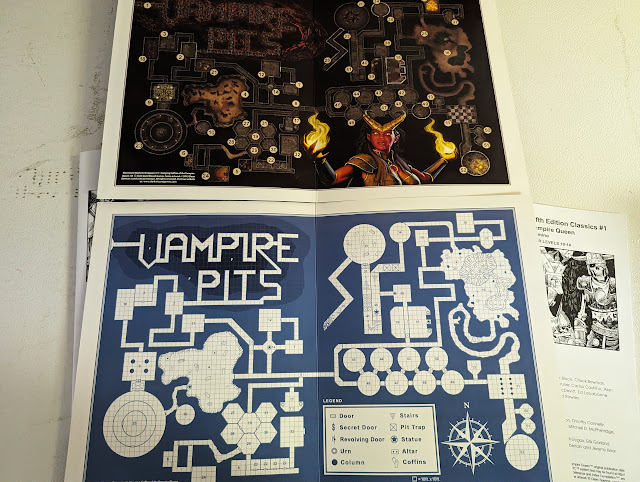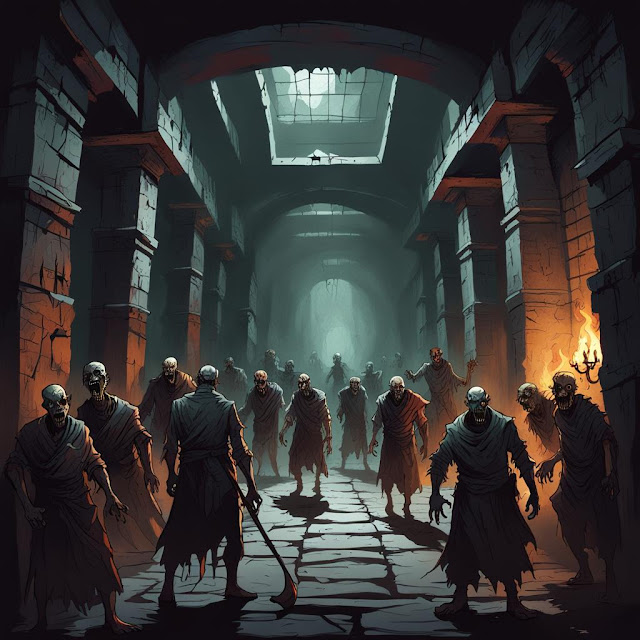[Fanzine Focus XXXIII] Black Pudding #7
 On the tail of Old School Renaissance has come another movement—the rise of the fanzine. Although the fanzine—a nonprofessional and nonofficial publication produced by fans of a particular cultural phenomenon, got its start in Science Fiction fandom, in the gaming hobby it first started with Chess and Diplomacy fanzines before finding fertile ground in the roleplaying hobby in the 1970s. Here these amateurish publications allowed the hobby a public space for two things. First, they were somewhere that the hobby could voice opinions and ideas that lay outside those of a game’s publisher. Second, in the Golden Age of roleplaying when the Dungeon Masters were expected to create their own settings and adventures, they also provided a rough and ready source of support for the game of your choice. Many also served as vehicles for the fanzine editor’s house campaign and thus they showcased how another DM and group played said game. This would often change over time if a fanzine accepted submissions. Initially, fanzines were primarily dedicated to the big three RPGs of the 1970s—Dungeons & Dragons, RuneQuest, and Traveller—but fanzines have appeared dedicated to other RPGs since, some of which helped keep a game popular in the face of no official support.Since 2008 with the publication of Fight On #1, the Old School Renaissance has had its own fanzines. The advantage of the Old School Renaissance is that the various Retroclones draw from the same source and thus one Dungeons & Dragons-style RPG is compatible with another. This means that the contents of one fanzine will be compatible with the Retroclone that you already run and play even if not specifically written for it. Labyrinth Lord and Lamentations of the Flame Princess Weird Fantasy Roleplay have proved to be popular choices to base fanzines around, as has Swords & Wizardry.
On the tail of Old School Renaissance has come another movement—the rise of the fanzine. Although the fanzine—a nonprofessional and nonofficial publication produced by fans of a particular cultural phenomenon, got its start in Science Fiction fandom, in the gaming hobby it first started with Chess and Diplomacy fanzines before finding fertile ground in the roleplaying hobby in the 1970s. Here these amateurish publications allowed the hobby a public space for two things. First, they were somewhere that the hobby could voice opinions and ideas that lay outside those of a game’s publisher. Second, in the Golden Age of roleplaying when the Dungeon Masters were expected to create their own settings and adventures, they also provided a rough and ready source of support for the game of your choice. Many also served as vehicles for the fanzine editor’s house campaign and thus they showcased how another DM and group played said game. This would often change over time if a fanzine accepted submissions. Initially, fanzines were primarily dedicated to the big three RPGs of the 1970s—Dungeons & Dragons, RuneQuest, and Traveller—but fanzines have appeared dedicated to other RPGs since, some of which helped keep a game popular in the face of no official support.Since 2008 with the publication of Fight On #1, the Old School Renaissance has had its own fanzines. The advantage of the Old School Renaissance is that the various Retroclones draw from the same source and thus one Dungeons & Dragons-style RPG is compatible with another. This means that the contents of one fanzine will be compatible with the Retroclone that you already run and play even if not specifically written for it. Labyrinth Lord and Lamentations of the Flame Princess Weird Fantasy Roleplay have proved to be popular choices to base fanzines around, as has Swords & Wizardry.Black Pudding is a fanzine that is nominally written for use with Labyrinth Lord and as of Black Pudding No. 6, for use with Old School Essentials as well, so is compatible with other Retroclones, but it is not a traditional Dungeons & Dragons-style fanzine. For starters, it is all but drawn rather than written, with artwork that reflects a look that is cartoonish, a tone that is slightly tongue in cheek, and a gonzo feel. Its genre is avowedly Swords & Sorcery, as much Fafhrd and the Gray Mouser as Conan the Barbarian. Drawn from the author’s ‘Doomslakers!’ house rules and published by Random Order via Square Hex, Black Pudding’s fantasy roleplaying content that is anything other than the straight-laced fantasy of Dungeons & Dragons, but something a bit lighter, but still full of adventure and heroism. Issues one, two, and three showcased the author’s ‘Doomslakers!’ house rules with a mix of new character Classes, spells, magic items, monsters, NPCs, and adventures, whilst four also included the author’s ‘OSR Play book’, his reference for running an Old School Renaissance game, essentially showing how he runs his own campaign. Issue five included a similar mix of new Classes, NPCs, and an adventure, but did begin to suggest a campaign setting, which six also continued as well as containing its owning wilderness area for the Player Characters to explore.
Black Pudding No. 7 continues in the same vein as Black Pudding No. 5 and Black Pudding No. 6, containing a mix of new Character Classes, a few monsters, and expanded descriptions of Yria, part of the ‘Doomslakers’ campaign. The issue, though, begins with four new Classes, whose quality varies. The first is the ‘Rat Bastard’, the offspring of Wererat and Human parentage. Treated like a Chaotic Thief, the Class has the ability to shift into a Wererat and use a Claw and Bite attack, but takes extra damage from silver. The Class also has a strong sense of smell, is naturally stealthy and sneaky, including being able to escape bonds and cages. The Turncoat ability forces the ‘Rat Bastard’ to betray everyone if offered more money than the Class is currently receiving… The ‘Rat Bastard’ is intentionally evil/Chaotic Class, suitable for NPCs, most obviously, but also for a campaign where the players are playing evil/Chaotic Classes. If the ‘Rat Bastard’ has a role in certain campaigns, the role of the remaining three Classes is uncertain except for sillier or gonzo campaigns. The ‘Iggy’ Class is a crude, shirtless risk-taking brawler whose ‘Lust for Life’ random, jerky battle dance gives him Armour Class bonuses despite being able to wear armour on his head and legs, make unarmed attacks, steal weapons and use them, and whilst he is partially immune to mind-affecting sleep and spells and all manner of intoxicants, he throws himself into danger, often harming himself in the process. The ‘Flamer’ is an Angel, but on fire, which inflicts fire damage, including the Magic Missile-like Fireburst, block damage with a Fire Shield, can Fly daily, and is, of course, immune to fire. Unfortunately, the ‘Flamer’ incinerates any armour not magically designed for it, has a chance of melting any weapon it uses, and can take double damage from the cold. The Class essentially feels like the Human Torch from the Fantastic Four. Lastly, the ‘Eyeball’ is a walking, talking eyeball, with sight-based abilities, such as being able to read any scroll and spot hidden and invisible things, plus it has the Thief abilities of Sneak, Pick Locks, and Pick Pockets. It suffers penalties in bright light though. It is intentionally a humorous Class, but really all three—the ‘Iggy’, the ‘Flamer’, and the ‘Eyeball’—are pieces of humour rather than necessarily humorous Classes. Their inclusion in any game would change its tone and it would have to be a specific type of campaign, gonzo and absurd, that they would work in.
The five new monsters in Black Budding No. 7 are quick and simply presented, with abilities and their minimal background details, all delivered as a series of bullet points. They include the ‘Rocky’, ‘Grave Crusader’, ‘Dracowisp’, ‘Tyrano-X’, and ‘Queen of the Dark Light’. The ‘Rocky’ and ‘Dracowisp’ consequently feel underwritten because their descriptions do not give them a role, whereas the ‘Grave Crusader’ is an Undead protector of burial sites. The ‘Tyrano-X’ is a Tyrannosaurus Rex-type creature, but intelligent and whose eggs are used in potions and royal breakfasts, so their eggs are hunted, even though one egg per nest poisons the eater. The ‘Queen of the Dark Light’ is a villainous sorcereress, who relishes in the shadows, maintains a coven of witches to serve her, is protected by Shadows, can summon Zombies, and so on. Both the ‘Tyrano-X’ and the ‘Queen of the Dark Light’ are given a full page each—the ‘Queen of the Dark Light’ on an appropriately black page—and so are given more detail, even if only mechanically, that the Game Master can more easily bring into her game.
Half of Black Budding No. 7 is devoted to ‘Yria: A Black Pudding Gazetteer’. It primarily focuses on the five cities of one region—Darkmirth, Frimmsreach, Kanebok, Seapath, and Summertop—with the spaces in-between filled in with rolls on the accompanying ‘d66’ table. These are only given thumbnail descriptions, whereas the individual cities and their environs are given a page each. Darkmirth is described as being ruled by a one kind king whose mind has been lost to the darkness of the Shadow Shrine and black sword in hand, demands the city be made black… Seaport is perched on a cliff over an angry sea and behind a mountain range, but the protection of the god, Krolton, the Blazing Heart, ensures it offers a safe harbour and posterity for the incredibly wealthy guilds and merchants. Underneath lie broken layers of the sewers and older cities, infested and haunted by creatures and monsters that lurk deep within. Here there is opportunity for adventurers to delve deep and find work in a city dominated by guilds—merchants, thieves, and assassins.
‘The Mythos of Yria’ present the pantheon of gods worshipped across Yria. How Mother Nest, the Moon, screamed and birthed life into the world over and over as the Black Wing, the great bird of death, swooped down and snatched it up again and again from around Nexus, the World Tree. The twelve gods are described in detail, including each one’s physical form, how it is worshipped, the requirements of its clerics, what is seen when standing in its presence, and what are the portents of its coming… This the Worm Witch, Mother of 100 Dooms takes the form of a medusa with worm hair, her robes tattered and old, her belly swollen with child, silver mirror eyes, surrounded by one hundred children, each one a monster. She is worshipped in foul festivals of feasts of worms and rotten meat, child sacrifice, and worse… Her clerics must carry and eat worms to know her mysteries, carry daggers, smell disgusting, and summon worm-like monsters daily. Her Alignment varies between Neutral Evil and Chaotic Evil, and standing in her presence is to smell her foul breath, see her black fingernails, and hear her hissing rasp, whilst surrounded by wriggling worms, skittering creatures, and nausea. The portents of her coming include flowers wilting, hordes of bugs, food rotting, the Moon clouding over… Each of the twelve gods is detailed in similar fashion, in each case, adding to the richness of the Yria setting. There is a brutality to all twelve of these gods that suits the Swords & Sorcery genre.
Physically, Black Pudding No. 7 adheres to the same standards set by the previous issues. So plenty of good, if cartoonish artwork to give it a singular, consistent look, accompanied by similar cartography. As with previous issues of the fanzine, the potential and obvious problem with Black Pudding No. 7 is that its tone may not be compatible with the style of Dungeons & Dragons that a Labyrinth Lord or Game Master is running. The tone of Black Pudding is lighter, weirder, and in places just sillier than the baseline Dungeons & Dragons game, so the Game Master should take this into account when using the content of the fanzine.In terms of quality, Black Pudding No. 7 really divided in two. So, whilst it starts poorly with the four Classes, three of which are unlikely to see a lot of use in any game, the other half, consisting of ‘Yria: A Black Pudding Gazetteer’ and ‘The Mythos of Yria’ which together present a world and help bring it alive. Here there is scope for the Game Master to expand the world and make it her own by developing adventures for it and bringing it to live through play. A starting adventure or two would not go amiss in one of the locations detailed in ‘Yria: A Black Pudding Gazetteer’, perhaps in the pages of Black Pudding No. 8, but Black Pudding No. 7 really does provide a good introduction to the author’s home campaign of Yria.
















.jpg)











